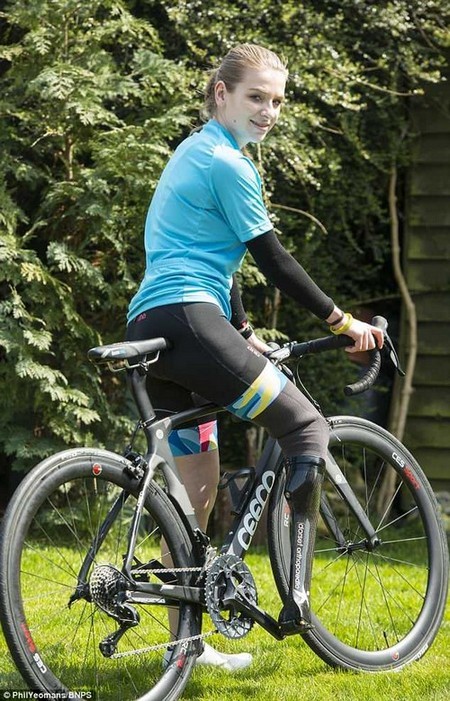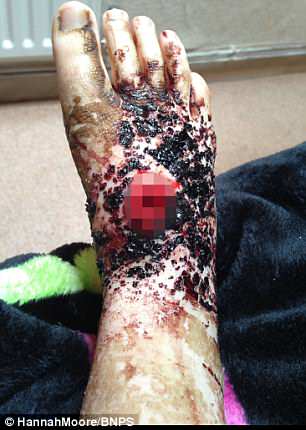A woman who paid £5,000 to have her leg amputated after the NHS refused today revealed it was the ‘best decision’ of her life.
Hannah Moore has become a champion triathlete and lost 4st (56lbs) in weight since the life-changing procedure, which was done privately.
The NHS told the 21-year-old that it would not carry out an amputation because it was not the recommended treatment for her condition and may not work.
A routine procedure to treat an ingrown toenail when she was 15 led to the poorly understood Complex Regional Pain Syndrome.
It blighted her life for four years, leaving her in severe pain and also led to a battle with ulcers, which became infected and led to the life-threatening sepsis.
More than 50 operations and skin grafts failed to treat the ulcers on her foot, and the unbearable pain left her wheelchair-bound.
Two years ago, Miss Moore, from Sherborne, Dorset, made the decision to have her right leg amputated to stop the pain – and she hasn’t looked back since.
Hannah Moore, 21, who paid £5,000 to have her leg amputated, said it was the best decision of her life after she lost 4st (56lbs) in weight and became a champion triathlete

The NHS told the 21-year-old that it would not carry out an amputation because it was not the recommended treatment for her condition and may not work

Miss Moore said: ‘I have achieved so much more than I ever thought I would and this is just the beginning which is very exciting’ (pictured before her weight loss)
Miss Moore, who now weighs 8st 7lbs (119lbs), has gone from strength to strength, becoming a super-fit triathlete.
She is now aiming to compete at the Tokyo Paralympics in 2020 and has been fitted with a revolutionary prosthetic cycling leg to help propel her to a gold medal.
Speaking about her decision to have her right leg amputated for the first time, Miss Moore said: ‘Since having my amputation I’ve never felt sorry for myself.
‘It’s all been about making the most out of situation showing to myself as much as anyone that a “disability” doesn’t have to define what you can and can’t do.
‘I have achieved so much more than I ever thought I would and this is just the beginning which is very exciting.’
How does her new leg work?
Miss Moore’s new custom-made £10,000 ‘cycling leg’ has been designed by leading prosthetics firm Dorset Orthopaedic.
The light-weight carbon-fibre limb clips directly to the pedal meaning no power is lost when she pushes down.
As well as enabling her to transfer more power to the bike, her new leg also provides her with far greater stability when going around corners.
Before, she used a normal prosthetic leg for the cycling part of the triathlon, which was attached to a trainer strapped to the pedal and was wobbly.

And since the life-changing surgery, Miss Moore, who now weighs 8st 7lbs (119lbs), has gone from strength to strength, becoming a super-fit triathlete

She claims her Complex Regional Pain Syndrome caused an infection, which turned her foot black and led to her fighting for her life in hospital after it triggered sepsis
Her thoughts on her new cycling leg
Miss Moore said the new leg should give her an edge over competitors. She said: ‘Having my leg amputated was the best decision I’ve ever made.
‘The things I have achieved I would never have without this operation. I am a British champion and now my dream is to compete in Tokyo.
‘The custom-made cycling leg is designed to be aerodynamic.’
She added: ‘It is a lot lighter than the leg I was previously using and because it attaches to the pedal there is a lot more power transfer.
‘With my normal leg there is a lot of movement in it so some of the power gets lost.
‘It feels amazing, really different, so much more comfortable and I have so much more balance going around corners.’
Miss Moore will remove the artificial limb and replace it with a blade for the running part of a triathlon.
Matthew Hughes, a prosthetist at Dorset Orthopaedic, said the streamlined design should help her improve her times on the bike.
He said: ‘Our design will help her generate more power and improve her times.
She is now aiming to compete at the Tokyo Paralympics in 2020 and has been fitted with a revolutionary prosthetic cycling leg to help propel her to a gold medal
Speaking about her decision to have her right leg amputated for the first time, Miss Moore said: ‘Since having my amputation I’ve never felt sorry for myself’
‘The science behind the shape of the leg is to make it more aerodynamic and we have used a pre-pregnated carbon fibre which hasn’t been used for cycling legs before.
‘There should be better power transfer and stability when she is pushing down on the pedals.
‘Hannah should be proud of the progress she has made in such a short space of time.’
Her ordeal
Miss Moore was a 15-year-old national karate champion when she underwent a routine procedure for an ingrowing toenail.
However, it triggered the rare Complex Regional Pain Syndrome (CRPS), which blighted her life for the next four years.
She suffered with severe pain and swelling and the blood vessels in her right foot became infected, which then triggered sepsis – a violent immune response.
Ulcers formed on her foot and despite over 50 operations and numerous skin grafts they would not heal. The situation got so bad that she was left wheelchair-bound.
At that point, Miss Moore made the tough decision to have her right leg amputated to stop the pain even though she was told there was no guarantee it would work.
The NHS refused to carry out the amputation since it was not their recommended treatment for CRPS and it argued she would still be in pain afterwards.
Miss Moore’s new custom-made £10,000 ‘cycling leg’ has been designed by leading prosthetics firm Dorset Orthopaedic
But other surgeons claimed there was a chance the operation could take away her pain so her family paid privately for the procedure in July 2016.
The gamble paid off as the Yeovil College student is no longer in pain and is the fittest she has been in her life.
Becoming a triathlon champion
Last August, she became the British PTS4 Paratriathlon Champion and she will begin a sports and exercise degree at Loughborough University later this year.
She said: ‘I started training three months after the amputation and obviously started off really slowly and have just built on that over time.
‘I did wheelchair racing before I had my leg amputated and I knew a few people who did triathlon through that, I’d always wanted to try it but I never could when I had my leg.
‘The variety of training for three sports I found very appealing.
‘For me the hardest times were before having my amputation as I was having operations almost every week in London and the pain was so wearing.’



